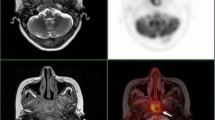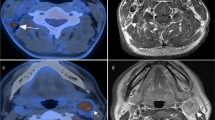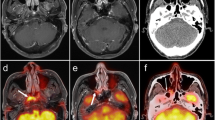Abstract
Purpose
While FDG PET/CT for the evaluation of nasopharyngeal carcinoma (NPC) in adult patients has documented advantages and disadvantages compared with conventional imaging, to our knowledge, no studies of FDG PET/CT for the evaluation of NPC in pediatric patients have been performed. In this investigation, we studied the utility of FDG PET/CT in children with NPC.
Methods
The study group comprised 18 children with biopsy-proven NPC who underwent FDG PET/CT and MRI (total 38 pairs of images). All baseline and follow-up FDG PET/CT and MRI studies were independently reviewed for restaging of disease.
Results
The concordance between FDG PET/CT and MRI in T, N, and overall staging was 29%, 64%, and 43%, respectively. Compared with MRI, FDG PET/CT yielded lower T and overall staging and showed less cervical and retropharyngeal lymphadenopathy. The concordance between follow-up FDG PET/CT and MRI was 79% overall and 100% 9 months after therapy. In patients who achieved complete remission, FDG PET/CT showed disease clearance 3–6 months earlier than MRI. There were no false-positive or false-negative FDG PET/CT scans during follow-up.
Conclusion
FDG PET/CT may underestimate tumor extent and regional lymphadenopathy compared with MRI at the time of diagnosis, but it helps to detect metastases and clarify ambiguous findings. FDG PET/CT is sensitive and specific for follow-up and enables earlier determination of disease remission. FDG PET/CT is a valuable imaging modality for the evaluation and monitoring of NPC in pediatric patients.






Similar content being viewed by others
References
Ries LAG, Smith MA, Gurney JG, Linet M, Tamra T, Young JL, et al., editors. Cancer incidence and survival among children and adolescents: United States SEER Program 1975–1995. Bethesda, MD: National Cancer Institute, SEER Program. NIH Pub. No. 99-4649; 1999.
Pappo AS, Rodgiguez-Galindo C, Furman WL. Management of infrequent cancers of childhood. In: Pizzo PA, Poplack DG, editors. Principles and practice of pediatric oncology. 6th ed. Philadelphia: Lippincott Williams & Wilkins; 2010. p. 1098–101.
Ayan I, Kaytan E, Ayan N. Childhood nasopharyngeal carcinoma: from biology to treatment. Lancet Oncol. 2003;4:13–21.
Stambuk HE, Patel SG, Mosier KM, Wolden SL, Holodny AI. Nasopharyngeal carcinoma: recognizing the radiographic features in children. AJNR Am J Neuroradiol. 2005;26:1575–9.
Lin XP, Zhao C, Chen MY, Fan W, Zhang X, Zhi SF, et al. Role of 18F-FDG PET/CT in diagnosis and staging of nasopharyngeal carcinoma. Ai Zheng. 2008;27:974–8.
Chang JT, Chan SC, Yen TC, Liao CT, Lin CY, Lin KJ, et al. Nasopharyngeal carcinoma staging by (18)F-fluorodeoxyglucose positron emission tomography. Int J Radiat Oncol Biol Phys. 2005;62:501–7. doi:10.1016/j.ijrobp.2004.09.057.
Yen TC, Chang JT, Ng SH, Chang YC, Chan SC, Lin KJ, et al. The value of 18F-FDG PET in the detection of stage M0 carcinoma of the nasopharynx. J Nucl Med. 2005;46:405–10.
Liu FY, Chang JT, Wang HM, Liao CT, Kang CJ, Ng SH, et al. [18F]fluorodeoxyglucose positron emission tomography is more sensitive than skeletal scintigraphy for detecting bone metastasis in endemic nasopharyngeal carcinoma at initial staging. J Clin Oncol. 2006;24:599–604. doi:10.1200/JCO.2005.03.8760.
Yu DF, Zuo CT, Dai JZ, Dong MJ, Zhao J, Lin XT, et al. Application of 18F-FDG PET/CT scan in following-up of nasopharyngeal carcinoma after radiotherapy. Ai Zheng. 2004;23:1538–41.
Wu DH, Chen LH. Clinical value of 18F-fluoro-2-deoxy-D-glucose positron emission tomography in detecting recurrent nasopharyngeal carcinoma at the parapharyngeal space after radiotherapy. Di Yi Jun Yi Da Xue Xue Bao. 2003;23:159–61.
Peng N, Yen S, Liu W, Tsay D, Liu R. Evaluation of the effect of radiation therapy to nasopharyngeal carcinoma by positron emission tomography with 2-[F-18]fluoro-2-deoxy-D-glucose. Clin Positron Imaging. 2000;3:51–6.
Ng SH, Chan SC, Yen TC, Chang JT, Liao CT, Ko SF, et al. Staging of untreated nasopharyngeal carcinoma with PET/CT: comparison with conventional imaging work-up. Eur J Nucl Med Mol Imaging. 2009;36:12–22. doi:10.1007/s00259-008-0918-7.
King AD, Ma BB, Yau YY, Zee B, Leung SF, Wong JK, et al. The impact of 18F-FDG PET/CT on assessment of nasopharyngeal carcinoma at diagnosis. Br J Radiol. 2008;81:291–8. doi:10.1259/bjr/73751469.
Zhang GY, Liu LZ, Wei WH, Deng YM, Li YZ, Liu XW. Radiologic criteria of retropharyngeal lymph node metastasis in nasopharyngeal carcinoma treated with radiation therapy. Radiology. 2010;255:605–12. doi:10.1148/radiol.10090289.
Ng SH, Chang JT, Chan SC, Ko SF, Wang HM, Liao CT, et al. Nodal metastases of nasopharyngeal carcinoma: patterns of disease on MRI and FDG PET. Eur J Nucl Med Mol Imaging. 2004;31:1073–80. doi:10.1007/s00259-004-1498-9.
Comoretto M, Balestreri L, Borsatti E, Cimitan M, Franchin G, Lise M. Detection and restaging of residual and/or recurrent nasopharyngeal carcinoma after chemotherapy and radiation therapy: comparison of MR imaging and FDG PET/CT. Radiology. 2008;249:203–11. doi:10.1148/radiol.2491071753.
King AD, Ahuja AT, Leung SF, Lam WW, Teo P, Chan YL, et al. Neck node metastases from nasopharyngeal carcinoma: MR imaging of patterns of disease. Head Neck. 2000;22:275–81.
Mao YP, Liang SB, Liu LZ, Chen Y, Sun Y, Tang LL, et al. The N staging system in nasopharyngeal carcinoma with radiation therapy oncology group guidelines for lymph node levels based on magnetic resonance imaging. Clin Cancer Res. 2008;14:7497–503. doi:10.1158/1078-0432.CCR-08-0271.
Ng SH, Chan SC, Yen TC, Liao CT, Chang JT, Ko SF, et al. Comprehensive imaging of residual/ recurrent nasopharyngeal carcinoma using whole-body MRI at 3T compared with FDG-PET-CT. Eur Radiol. 2010;20:2229–40. doi:10.1007/s00330-010-1784-9.
Sakai O, Curtin HD, Romo LV, Som PM. Lymph node pathology. Benign proliferative, lymphoma, and metastatic disease. Radiol Clin North Am. 2000;38:979–98. x.
Ng WT, Lee AW, Kan WK, Chan J, Pang ES, Yau TK, et al. N-staging by magnetic resonance imaging for patients with nasopharyngeal carcinoma: pattern of nodal involvement by radiological levels. Radiother Oncol. 2007;82:70–5. doi:10.1016/j.radonc.2006.11.010.
Edge SB, Byrd DR, Compton CC, Fritz AG. AJCC cancer staging manual. 7th ed. Chicago, IL: Springer; 2009.
Cohen J. A coefficient of agreement for nominal scales. Educ Psychol Meas. 1960;20:37–56.
Landis JR, Koch GG. The measurement of observer agreement for categorical data. Biometrics. 1977;33:159–74.
Gordin A, Golz A, Daitzchman M, Keidar Z, Bar-Shalom R, Kuten A, et al. Fluorine-18 fluorodeoxyglucose positron emission tomography/computed tomography imaging in patients with carcinoma of the nasopharynx: diagnostic accuracy and impact on clinical management. Int J Radiat Oncol Biol Phys. 2007;68:370–6. doi:10.1016/j.ijrobp.2006.12.028.
Wang GH, Lau EW, Shakher R, Binns DS, Hogg A, Drummond E, et al. Clinical application of (18)F-FDG PET/CT to staging and treatment effectiveness monitoring of nasopharyngeal carcinoma. Ai Zheng. 2007;26:638–42.
Zhang GY, Hu WH, Liu LZ, Wu HB, Gao YH, Li L, et al. Comparison between PET/CT and MRI in diagnosing lymph node metastasis and N staging of nasopharyngeal carcinoma. Zhonghua Zhong Liu Za Zhi. 2006;28:381–4.
Hu WH, Zhang GY, Liu LZ, Wu HB, Li L, Gao YH, et al. Comparison between PET-CT and MRI in diagnosing nodal metastasis of nasopharyngeal carcinoma. Ai Zheng. 2005;24:855–60.
Tang LL, Ma J, Chen Y, Zong JF, Sun Y, Wang Y, et al. The values of MRI, CT, and PET-CT in detecting retropharyngeal lymph node metastasis of nasopharyngeal carcinoma. Ai Zheng. 2007;26:737–41.
Cao KJ, Li Y, Xie GF, Hong MH. Prognostic factors in nasopharyngeal carcinoma in childhood and adolescence. Zhonghua Zhong Liu Za Zhi. 2006;28:134–7.
Sahraoui S, Acharki A, Benider A, Bouras N, Kahlain A. Nasopharyngeal carcinoma in children under 15 years of age: a retrospective review of 65 patients. Ann Oncol. 1999;10:1499–502.
Li J, Pan YD, Yin JL, Li XD. Analysis of standard uptake values of 18F-FDG PET/CT in relation to pathological classification and clinical staging of nasopharyngeal carcinoma. Nan Fang Yi Ke Da Xue Xue Bao. 2008;28:1923–4.
Lee SW, Nam SY, Im KC, Kim JS, Choi EK, Ahn SD, et al. Prediction of prognosis using standardized uptake value of 2-[(18)F] fluoro-2-deoxy-d-glucose positron emission tomography for nasopharyngeal carcinomas. Radiother Oncol. 2008;87:211–6. doi:10.1016/j.radonc.2008.01.009.
Yen TC, Lin CY, Wang HM, Huang SF, Liao CT, Kang CJ, et al. 18F-FDG-PET for evaluation of the response to concurrent chemoradiation therapy with intensity-modulated radiation technique for stage T4 nasopharyngeal carcinoma. Int J Radiat Oncol Biol Phys. 2006;65:1307–14. doi:10.1016/j.ijrobp.2006.02.031.
Chang MC, Tsai SC, Lin WY. 18F-fluorodeoxyglucose uptake in different histological subtypes of nasopharyngeal carcinoma. J Laryngol Otol. 2009;123:656–61. doi:10.1017/S002221510800368X.
Xie P, Yue JB, Fu Z, Feng R, Yu JM. Prognostic value of 18F-FDG PET/CT before and after radiotherapy for locally advanced nasopharyngeal carcinoma. Ann Oncol. 2010;21(5):1078–82. doi:10.1017/10.1093/annonc/mdp430
Chan SC, Yen TC, Ng SH, Lin CY, Wang HM, Liao CT, et al. Differential roles of 18F-FDG PET in patients with locoregional advanced nasopharyngeal carcinoma after primary curative therapy: response evaluation and impact on management. J Nucl Med. 2006;47:1447–54.
Chen YR, Gu MX, Li WX, Pan Y. Detection of residue of nasopharyngeal carcinoma with FDG PET. Ai Zheng. 2002;21:651–3.
Zeng L, Huang XM, Lu TX, Zheng YQ, Chen QJ, Chen Y, et al. Diagnosis of recurrent or residual nasopharyngeal carcinomas in the skull base area with F-18-fluoro-deoxyglucose positron emission tomography. Zhonghua Er Bi Yan Hou Tou Jing Wai Ke Za Zhi. 2006;41:517–20.
Yen RF, Chen TH, Ting LL, Tzen KY, Pan MH, Hong RL. Early restaging whole-body (18)F-FDG PET during induction chemotherapy predicts clinical outcome in patients with locoregionally advanced nasopharyngeal carcinoma. Eur J Nucl Med Mol Imaging. 2005;32:1152–9. doi:10.1007/s00259-005-1837-5.
Acknowledgments
We thank Sandra Gaither for secretarial support and David Galloway for scientific editing. The work was supported by the American Lebanese Syrian Associated Charities.
Conflicts of interest
None.
Author information
Authors and Affiliations
Corresponding author
Rights and permissions
About this article
Cite this article
Cheuk, D.K.L., Sabin, N.D., Hossain, M. et al. PET/CT for staging and follow-up of pediatric nasopharyngeal carcinoma. Eur J Nucl Med Mol Imaging 39, 1097–1106 (2012). https://doi.org/10.1007/s00259-012-2091-2
Received:
Accepted:
Published:
Issue Date:
DOI: https://doi.org/10.1007/s00259-012-2091-2




